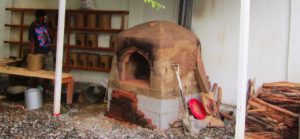
The Ahiasun kiln & stove factory in operation. Firing used about $6 of low-grade fuel — about what’s in the stack at R (or maybe less?) Note stove bodies on shelf.
Jon and Flip Anderson have been working with stoves and ovens for some years now (HPP regulars may remember their rocket powered oven design.) Last February, they helped teach at the Winter Stove Workshop put on by Aprovecho and InStove. Aprovecho Research Center (ARC) was consulting for Mercy Corps in East Timor, who had sent their Program Manager for Renewable Energy, Will Baron, who has responsibility for all programming related to energy, poverty, lighting, electricity, appropriate cooking technology and sustainable cooking fuels.
Mercy Corps’ East Timorese stove program imports stove components from China and trains locals to make and sell completed stoves as a business opportunity, and as a way to improve health and air quality and reduce deforestation. But the stoves were more expensive than most people could pay, heavy, and expensive to transport. So Mercy Corps brought in Jon and Flip as short term consultants to help make needed improvements.
The first challenge was to develop a stove that locals could make — and fire — into a more durable, better insulated (and thus more fuel efficient) stove that wouldn’t fall apart while being trucked over bad roads. The second challenge was to design a prototype institutional stove that could also be produced locally from local materials. The first request required building a kiln to fire stove parts, and this is what we’re sharing with you here: a two burner rocket-powered kiln capable of reaching 1,000° Celsius — and made of local clay, sawdust, and wood ash!
Here is Jon and Flip’s wonderful slideshow on the building and firing of their rocket-powered kiln, complete w/very detailed construction sequences:
https://picasaweb.google.com/Jonnygms/RocketStoveKiln#slideshow/5941839083345658770
and here are some links to more background information about the project:
http://www.globalenvision.org/2013/05/09/interview-bringing-light-and-stoves-rural-east-timor
http://www.mercycorps.org/sites/default/files/guide_to_stoves.pdf


The link to the slide show is not working.
oh crapola, Sarah ..Yeah soitemmes it really IS hard to say it’s just dirt , isn’t it ..I can imagine you felt felt just like I did at GiG a big fat kick in the chest ..Say when you bisque those pieces .can you send me one? I really think I could use one for inspiration!!!! Because SOMEDAY I’m really gonna carry out that design we discussed ..and having a bigass paw of yours to stare at would be rockin’!BTW ..I’m REALLY sorry that dog didn’t make it probably some sort of secret defect somewhere that you didn’t know about so it kamikazeed.
Thank you. Thank you. Thank you for this post and information. Loads of detail and something I have been considering and researching. I hope within the next year to put everything I have read/learned together and build something similar. I will make sure I take as many photographs and notes as Jon in the attached link above and likewise share them. Then it will be onto building Cabin Stove 2.0 once details are available. Cheers, Glynis
I NEED TO MAKE A SMALL POTTERY OR CLAY KILN. COULD YOU PLEASE TELL ME HOW TO MAKE A SMALL WOOD BURNING KILN. I TRULY WOULD APPRECIATE IT. THE COWBOY PREACHER.
Jimmy,
It is possible to fire clay in a campfire or a woodstove. A kiln is just a fire enclosed in a box of some kind, with a big chimney. The more draft, the higher the heat. But the best I can offer is the page where you made this comment. There is a lot of other information and many stories on the web.
good luck.